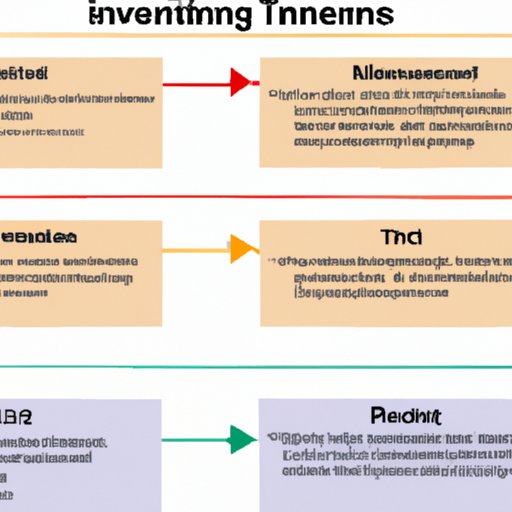Introduction
Investment activities involve taking a risk in order to gain financial reward. It is a process of putting money into something with the expectation of gaining a return. In other words, it is an act of purchasing an asset or security with the goal of making a profit by selling it at a higher price than you paid for it. This can be done through stocks, bonds, mutual funds, real estate, commodities, futures, and alternative investments.

Exploring the Basics of Investment Activities: An Overview
Before diving into the different types of investment activities, it is important to understand the basics of investing. Investing involves buying assets or securities with the hope that they will increase in value over time. The goal is to make a profit by selling them for more than you paid for them.
What is an Investment?
An investment is an asset or security purchased with the expectation of generating income or capital gains. Investments are typically made with the goal of increasing wealth or providing a stable income. Common investments include stocks, bonds, mutual funds, real estate, commodities, futures, and alternative investments.
Types of Investments
There are many types of investments, each with its own set of risks and rewards. Stocks and bonds are two of the most popular types of investments. Stocks represent ownership in a company, while bonds represent loans made to a company or government entity. Mutual funds and exchange-traded funds (ETFs) are baskets of investments that can provide diversification and professional management. Real estate is another popular type of investment, as are commodities and futures, which are contracts to buy or sell a specific commodity at a predetermined price at a certain point in the future. Alternative investments, such as hedge funds and private equity funds, often require large investments and offer the possibility of high returns.
Goals & Objectives of Investing
The primary goal of investing is to generate income or capital gains. However, there are many other reasons why people invest. Some investors seek to grow their wealth over time, while others may want to preserve their capital or take advantage of tax incentives. Other investors may be looking for a steady stream of income, or to diversify their portfolios. No matter what the goal, it is important to understand the risks and rewards associated with any given investment.

Types of Investment Activities and How They Work
Now that we have explored the basics of investing, let’s look at some of the different types of investment activities and how they work. Each type of investment has its own unique characteristics and risks, so it is important to understand how they work before investing.
Stocks & Bonds
Stocks represent ownership in a company, while bonds are loans made to a company or government entity. When you purchase a stock, you are buying a portion of the company. As the company grows and earns profits, the value of your stock will increase. Bonds, on the other hand, are loans that pay a fixed interest rate over a certain period of time. When the bond matures, the issuer pays back the loan plus interest.
Mutual Funds & ETFs
Mutual funds and exchange-traded funds (ETFs) are baskets of investments that offer diversification and professional management. Mutual funds are managed by trained professionals who choose the investments within the fund. ETFs are similar to mutual funds but they trade like stocks on the stock market. Both offer the potential for growth and income, but come with fees and other costs.
Real Estate
Real estate is another popular type of investment, as it can provide both income and capital appreciation. Investing in real estate can take many forms, from buying and renting out a property to developing land or investing in a real estate investment trust (REIT). Investing in real estate requires knowledge of the local market and a good understanding of the legal and financial aspects of owning property.
Commodities & Futures
Commodities and futures are contracts to buy or sell a specific commodity at a predetermined price at a certain point in the future. Commodities, such as gold, oil, and wheat, can be traded on exchanges around the world. Futures are used by producers, consumers, and speculators to manage the risks associated with fluctuating prices. Investing in commodities and futures can be risky, but also offers the potential for high returns.
Alternative Investments
Alternative investments, such as hedge funds and private equity funds, often require large investments and offer the possibility of high returns. These investments are not regulated by the Securities and Exchange Commission (SEC) and can be illiquid, meaning it may be difficult to sell your investment when you want to. Alternative investments can be complex and are best suited for experienced investors.
Common Investment Strategies & Their Benefits
Once you understand the different types of investments, you can begin to develop a strategy for investing. Different strategies offer different benefits, so it is important to find one that fits your goals and risk tolerance.
Buy & Hold
The buy and hold strategy involves buying stocks or other investments and holding onto them for the long term. This strategy focuses on the long-term growth of the underlying investments, rather than trying to time the market. The benefit of this strategy is that it allows investors to take advantage of the compounding effect, where the returns earned on the initial investment are reinvested and earn additional returns.
Value Investing
The value investing strategy involves buying stocks or other investments that are undervalued and have the potential to increase in value over time. This strategy is based on the idea that some stocks or investments may be temporarily undervalued and can be bought at a discount. Value investors look for companies with strong fundamentals and a history of long-term growth.
Growth Investing
Growth investing involves buying stocks or other investments with the expectation that they will increase in value over time. This strategy focuses on companies that have the potential for above-average growth, such as innovative technology companies or those in emerging markets. Growth investors often use technical analysis to identify stocks with strong momentum.
Momentum Investing
The momentum investing strategy involves buying stocks or other investments that have recently performed well and have the potential to continue doing so. This strategy is based on the idea that stocks or investments that have recently gained in value will continue to do so in the near term. Momentum investors use technical analysis to identify stocks that are trending upward and have strong momentum.
The Risks & Rewards of Investing
It is important to understand the risks and rewards associated with any given investment. Investing carries the risk of losing all or part of your principal, so it is important to diversify your portfolio and understand the risks associated with any given investment.
Risk-Reward Tradeoffs
All investments carry some degree of risk, and the amount of risk you are willing to take will determine the potential rewards. For example, stocks and other equities tend to be riskier than bonds, but also offer the potential for higher returns. It is important to understand the risks and rewards associated with any given investment and to create a portfolio that is diversified across different asset classes.
Diversifying Your Portfolio
Diversification is an important part of any investment strategy. By spreading your investments across different asset classes, you can reduce the overall risk of your portfolio. This means that if one investment performs poorly, the others may help to mitigate the losses. Diversification can also help to protect against unexpected events, such as a recession or bear market.
Understanding Volatility
Volatility is a measure of how much an investment’s price can change over a given period of time. High volatility means that the price of an investment can quickly go up and down, while low volatility means that the price is more stable. It is important to understand the level of volatility associated with any given investment, as it can affect the potential returns.
Investing With an Eye Toward the Future
Investing can be a great way to build wealth, but it is important to have a plan and remain disciplined. It is also important to stay informed about the markets and the economy, as this can help you make better decisions about where to invest your money.
Staying Informed
Staying informed about the markets and the economy can help you make better decisions when it comes to investing. Reading financial news and staying abreast of market trends can help you identify opportunities and manage risk. You should also consider consulting with a financial advisor, who can provide valuable insight into the markets and help you develop a tailored investment strategy.
Developing a Plan
Developing a plan for investing is essential. You should set clear goals and objectives and decide on an appropriate asset allocation that meets your needs. It is important to have a plan and stick to it, as this will help ensure you are making the right decisions when it comes to investing.
Reevaluating Your Investment Strategy
As the markets and your personal circumstances change, it is important to reevaluate your investment strategy. Periodically reviewing your investments and portfolio can help you adjust your strategy to meet your changing needs. It is also important to keep track of taxes and fees associated with your investments, as these can have a significant impact on your returns.
Conclusion
Investment activities involve taking a risk in order to gain financial reward. There are many types of investments, each with its own unique risks and rewards. Understanding the basics of investing and the different types of investment activities is the first step in developing an effective investment strategy. It is important to understand the risks and rewards associated with any given investment and to diversify your portfolio. Finally, it is important to stay informed and develop a plan that meets your goals and risk tolerance.
(Note: Is this article not meeting your expectations? Do you have knowledge or insights to share? Unlock new opportunities and expand your reach by joining our authors team. Click Registration to join us and share your expertise with our readers.)
